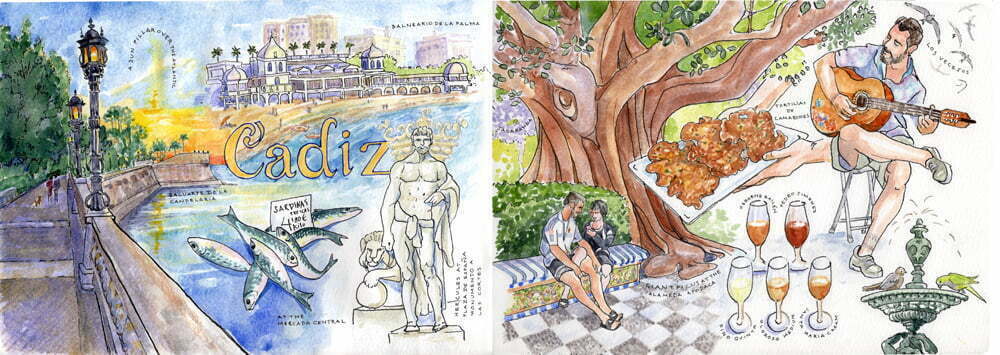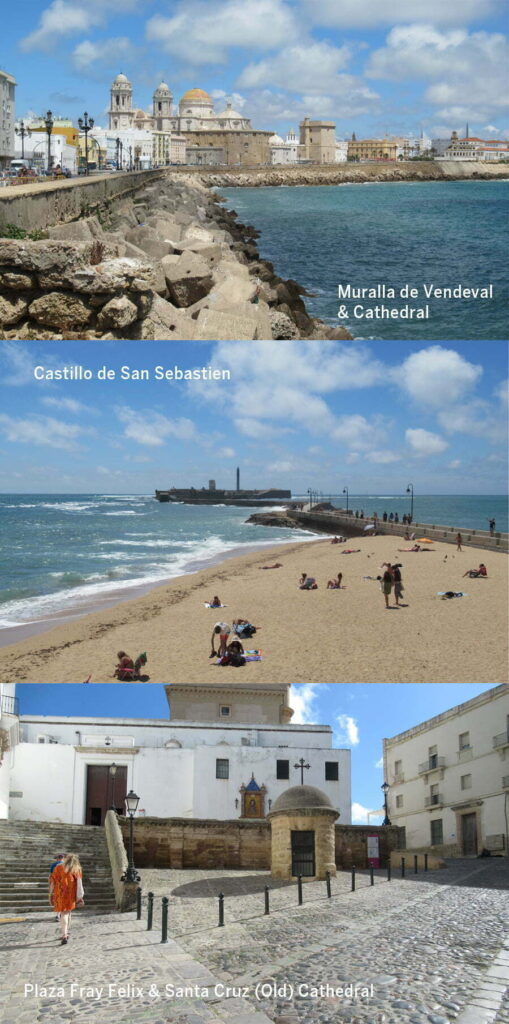
Anywhere you stand while visiting Cádiz most likely there’s some remnant of long-gone civilizations several meters beneath your feet. Cádiz, Spain is an ancient town perched on a skinny peninsula halfway between the Portuguese border and Gibraltar. It was once Phoenicia’s westernmost settlement, and mythology gave the town its hero, Heracles, who created the straits of Gibraltar and guarded the Mediterranean (not that successfully) from raiders.
Somewhere around 3,100 years ago the Phoenicians, traveling from what is now Lebanon, landed here in what was then an archipelago of sandy islands and decided it was a propitious spot to settle. They named it Gadir. Subsequent groups of visitor-invaders (Carthaginians, Romans, Visigoths, Moors, Corsairs, Dutch, English, French, etc.) appreciated the strategic value of this snippet of land reaching out into the Atlantic, and shimmed themselves in, around and on top of the original colony. While renovating the Tía Norica puppet theatre, digging revealed a precious archaeological find. Today, the site is preserved under glass deep below the theatre. It shows the juxtaposition of Phoenician streets and houses and the Roman (ever the practical ones) brining basins for preserving fish. I was moved by the human skeleton which clearly shows a man having perished painfully (in a fire), and the skeleton of a cat in the street. The docent explained that before the entry of the Phoenicians into western Europe, there were no cats here. Thank you Phoenicians!

I came here to meet up with some dear friends from San Francisco for a relaxing adventure together. We stayed in the chic Mentidero Barrio at the very nice Hotel de Francia y Paris. I arrived the evening before my friends did, and explored the neighborhood a bit. I discovered the heartbreakingly beautiful seaside promenade, the Alameda Apodaca, and was gifted a sunset (way out west here, the sun went down around 10pm!) with a rare sun pillar hovering over the Atlantic. (I was alerted to this kind of celestial phenomenon because I am a member of The Cloud Appreciation Society). The park overflows with bougainvillea bushes and jacaranda trees, as well as enormous ficus trees.

I quickly adapted to the Spanish schedule. It is especially handy for a tourist: Light breakfast around 9, visit some sites, lunch around 2pm, a siesta, and you’re ready to do more exploring (also the shops open around 4pm) until you’re hungry again, around 10pm. Because it was holiday, and because we discovered the best cocktail spot I’ve ever been to (Le Colonial), a cóctel de lujo sipped while looking out over the fading horizon followed.

The checkered tiles in this park alternate between squares of small river rocks and white marble. The park was built in the 19th century, when Cádiz enjoyed a period of wealth. I can’t imagine a landscape designer specifying this labour-intensive decoration for a public park today, alas. Nor the hand-painted Andalucian tiles that rim the fountains…
Speaking of building, I am always interested in the way a city is put together. The porous local rock, so obviously a kind of limestone, was used for all the older buildings. It’s crumbly, so many buildings on these narrow streets have ornate metal protections on their corners. The streets are VERY narrow, so we were in the shade most of the time. Apartments above us gain a bit of light with rectangular bay windows that jut into the street. I was quite disoriented most of the time as many streets are not named, they’re short, and connected at odd angles. This jumble of streets produces many serendipitous corner spaces, in which one can refuel alfresco.

We worked our way back in time, as our base barrio was developed in the prosperous second half of the 19th century. We walked down to the older neighborhoods, El Populo (mostly medieval), and the ancient Santa Maria barrio. Cádiz was a walled town, and it is said that gypsies camped in the moat outside the southern districts, bringing to Cádiz the sounds of flamenco. One can still walk through medieval archways, visit the Roman amphitheater, and see bits of the old walls. This is also where you can see the new Cathedral (Santa Cruz) and the old one, built from the old mosque.

I hadn’t swum in the Atlantic in over 20 years and was determined to dip in to its invigorating waters. Playa Caleta is right in town, in the La Viña barrio (used to be vineyards, until trade with the Americas became Cádiz’s main concern), with the 18th-century San Sebastian Castle jetty framing the southern side. Behind is a classic 1920’s resort, the De La Palma.
I have been learning Spanish these past 3+ years and was eager to practice. Like the rest of the Spanish (as opposed to the Mexicans on Netflix series), the Andalucians speak super fast, and to top my language difficulties, they tend to drop the endings off their palabras. Hence, for example, “Cádix” becomes “Cai”.
Part of the reason we gravitated to this part of Spain is that our Spanish teacher (online, of course) lives in the city across Cádiz Bay, Santa Maria (as in the Niña, the Pinta, the Santa Maria—Chris Columbus sailed from this port several times). Looking around the town of Santa Maria, I was reminded of the colonial origins of European America. Since I toured some of Latin America before visiting the parent country, I recognized from whence came this “Colonial Style” architecture.
It was great to see my teacher in person and meet her charming family. We were treated to an elaborate sherry tasting in Jerez at the Osborne bodega (in Spain, this means winery, as opposed to in the USA, where it indicates a small corner store run by Latino/as). The docent did a thorough explanation of the different aging processes, and the wines which emerge. However, he spoke so rapidly that later I had to go online for an explanation of the diverse kinds of Sherry and the elaborate way they are crafted. Most of what he said went right by me, but no translation was needed to appreciate the unique wines of our tasting, boasting 5 varieties of sherry, from pale dry Fino, to the rich caramel-dark Pedro Jimenez.
I must say something about the terrific food I had during my stay. Most culinarily impressive was Mercado Central which housed the broadest array of fish and shellfish I have ever seen. If Cádiz had a mascot, it would be a tunafish, as this animal was responsible for centuries of wealth here. The freshness of the seafood is validated by the clean look and smell of the market stalls.
As we were staying in a hotel, we ate every meal in restaurants. Our first evening together, we stumbled upon a great Tapas bar, Rosario Uno, right next to our homebase. My friends had friends who were friends with the owner of Meson Casa Antonio. We had a thoroughly enjoyable meal there. La Candela was another place to enjoy tapas, though not as excellent as the other 2. In Santa Maria we enjoyed a delightful lunch at Restaurant Maria Castaña, on the river Guadalete across the Bay. By the way, I wonder if the owner is some distant relative, as my French grandmother’s maiden name was the same…
Some of the Gaditana foods sampled here were: tortillas de camarones (shrimp fritters), salmorejo de queso (untranslateable: unctuous cold soup with fish, tomatoes, sherry vinegar, cheese and who knows what). Really terrific at Meson Casa Antonio. My favorite anywhere: alcachofas a la plancha (grilled artichokes with wonderful sauces). Papas aliñas can vary from really tasty to bland, but a nice starch to go along with the more savory tapas. There were seafood balls in sauce that are similar to French quenelles (Albóndigas de marisco).

I loved the atmosphere in Cádiz. The Gaditanos like to joke and have their own slang. Around the Market place were panels boasting their various unique words. The locals have flair (and lots of tatoos, as befits port denizens) and exude confidence and pride in their hometown. Perhaps it’s living in such a delightful, clean and beautiful city? The gentle climate? I wish I had had at least a couple of more days to better understand their long and complicated history (The Museo de los Cortes has a model of the city, which might have helped me orient myself, but it was closed every time I passed. It also might have given me a better explanation of what exactly happened in 1812, when the original Spanish Constitution was ratified there.) I’ll just have to come back.
